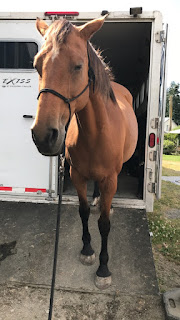by Mary Gallagher
Jerry Schmidt made a surprise appearance at our Friday ground work class last week, and gave us some really excellent bits of information regarding emotional fitness in saddling your horse. It’s tempting to think, aww, just tie them up and there’s no problem! But what we miss out on when we tie our horses for saddling, is a chance to see where our connection, communication, and cooperation is on that particular day before we ride. On the ground is the place to do that—not when we’re riding! This is particularly crucial with young horses, but any horse can be in a less than ideal state for saddling. If you care about fostering your connection to your horse in your every day activities, you’ll get something out of this short video.
I had one of my current young horses in training, Je te’, with me, and she was a perfect demo horse for Jerry. He showed us how to check the horse’s readiness to stand quietly for saddling. In fact, he made a very interesting point about standing still (that you’ll just have to watch the video to see!). Without that readiness, just a little bumbling on our part, or skittishness on their part, can throw off the process and send us back to square one.
Enjoy.





